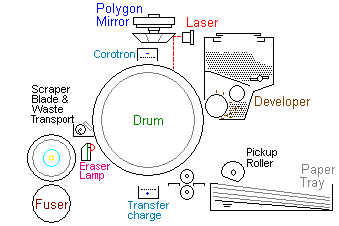| Laser Printing- Summary Printers > Laser > Summary | Navigation Icons Guide
|
This is a one-page outline of the laser printer or "electrophotography" principle.
Laser printers use a plastic toner powder fused to the paper as their ink. Printing is robust and can be of photographic quality. Using four toners in Cyan, Magenta, Yellow and Black gives colour printing, at the cost of adding some complexity to the mechanism.
The laser plays a comparatively small part in the printer. Technology in a laser printer is similar to that of a photocopier, only the light sources differ. The laser provides a tightly focused and rapidly changing light source.
Two principles form the basis of photocopiers and laser printers:
Electrostatic charges attract and repel particles. Feathers and hair stick to the surface of a balloon charged by rubbing against fabric and dust gathers round electical wiring. Electrophotography uses high voltages to attract toner powder.
Photoconductor material holds an electric charge when it is in the dark. In the light the molecules of the material gain free electrons and become conductors. Several materials show this behaviour - semiconductor metals like silicon and selenium for instance. A group of two layer plastics collectively called "organic photoconductors" or OPCs are commonly used.
Electrophotography puts these two ideas together. The photoconductive surface of a drum or belt is given a strong electric charge in the dark which it holds because it is acting as an insulator. Then parts of the surface are exposed to light and in those places the charge dissapears into a metal back plate. The light source used in photocopiers is an image from a document lit by a bright light. In a laser printer the image is usually scanned by a laser and a rotating mirror.
The photoconductor now holds a latent image with some parts of it's surface having a static electric charge and others non.
Toner powder with an electrical charge is next brought close to the photoconductor. Like charges repel so if the toner powder carries the same charge as the surface it will not stick. Conversely where the toner is charged and the surface is not material does stick. Different printers work different ways but sticking to discharged areas is normal because the laser does less work. The toner attracted to the photoconductor develops the latent image - so the mechanism that does this is a developer.
The image is now moved close to a sheet of paper. Opposite charges attract so placing a charge opposite to that on the drum under the paper will pull the toner powder off the photoconductor and onto the page.
The toner image has to be fixed to the paper and this is normally done by both heating and pressing it in a device called the fuser. A typical fuser has a pair of heated rollers and the paper passes between them. Toner melts onto the paper and binds to its fibers.
The photoconductor is discharged by an eraser lamp, its surface is cleaned of any surplus toner and it can then be re-used.
The light source used in most printers is a beam from a laser scanned back and forth by a mirror. The laser is usually an infra-red semiconductor type because these can be turned on and off (modulated) very rapidly. A plain mono sheet of text holds something like 35 million pixels arranged in 7000 lines 5000 pixels wide (at 600dpi) so the lasers ability to turn on and off rapidly is useful.
The pattern scanned can come direct from a users computer memory as a bit-map, however this isn't usually a very efficient way for computer and printer to communicate. Instead the computer sends text codes like ASCII or Unicode, a Print Control Language like PCL or "Postscript". Within the printer a "Raster Image Processor" (RIP) turns the codes into the raster scanned out by the laser.
Photoconductors can be made as flat plates, belts, rollers or drums. Forming the OPC into a drum is the usual approach. An OPC drum has mechanical stability in a compact shape, but keeps the various voltage- generating mechanisms spaced out so that they don't interact. The high voltage charge comes from a roller or wire at the top of the drum. Next the laser scans across its width. The developer is a roller running very close to the drum carrying the toner. The paper runs through the machine at the same time as the drum turns and the transfer voltage pulls the toner particles across onto the paper surface. Finally the drum turns past the cleaning station - a row of lights and a scraper blade.
To drive the drum and its asscociated rollers the printer has a motor and cog chain. A couple of clutches control the rollers that pick up and transport pages. High voltages used to move the toner are made by transformers driven by inverters.
Colour can be provided by having four successive mechanisms. Four mechanisms makes a large and expensive machine that can work quickly. Another approach is to have four developers each with its own colour on a carousel. The carousel turns to put cyan, magenta, yellow and black toners alongside the OPC drum in turn. The drum them drops each coloured image onto a storage drum or belt where it is held in place by successively higher voltages. Finally the completed image is transfered to the paper.
Paper with the image on it is finally passed through the fuser. The fuser melts the toner and presses the image into the paper. When the toner cools it gives an image that is very robust against anything that doesn't destroy the paper: damp and warmth for instance.


